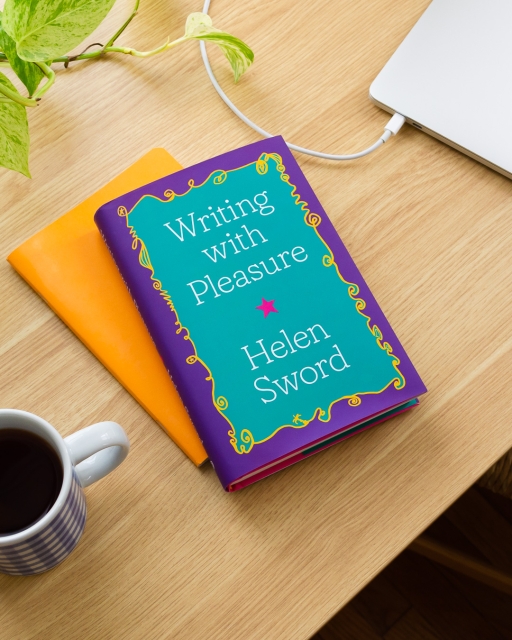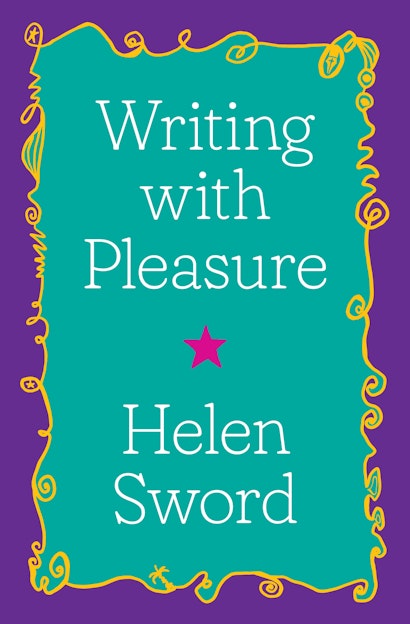Writing should be a pleasurable challenge, not a painful chore. Writing with Pleasure empowers academic, professional, and creative writers to reframe their negative emotions about writing and reclaim their positive ones. By learning how to cast light on the shadows, you will soon find yourself bringing passion and pleasure to everything you write.
How did this book come about?
HS: Writing with Pleasure is my fourth research-based book on academic writing but the first to dive deep into writing-related emotions. All writers experience such emotions—whether visceral or nuanced, motivating or crippling, positive or negative—but those of us who write for a living are generally discouraged from talking about them. Writing is serious business, we’re told; emotions are frivolous. Indeed, I could name several dozen well-regarded academic writing guides that take this approach, whether implicitly or explicitly. In a publish-or-perish environment, you’re not supposed to enjoy writing; just put your head down and get on with it.
Over the years, however, I’ve uncovered a curious paradox that belies this earnest eat-your-vegetables advice. In a series of in-depth interviews that I conducted for my 2017 book Air & Light & Time & Space: How Successful Academics Write, I asked one hundred successful academic writers to describe the main emotions that they associate with their academic writing. Pleasure came up more often than any other emotion, closely followed enjoyment and satisfaction. Productivity and pleasure, I found, walk hand in hand.
Where did you go from there?
HS: I set out to gather “narratives of pleasure” from advanced academic writers across the disciplines and around the world (12 countries in all). Most of them were graduate students, post-doctoral researchers, faculty members, or research-active university staff such as educational developers and writing center directors. My final “Writing with Pleasure” workshop took place in Santiago in November 2019, just as Chile was descending into a period of revolutionary chaos and martial law. Little did I suspect that virtually all global travel would grind to a halt a few short months later!
The 590 responses that I collected proved, as I had hoped, richly textured and delightfully varied. When asked to describe a time in their life when they associated writing with pleasure, some respondents recalled scenes of writing from early childhood; others chose the writing that they had done that very morning before breakfast. Some rhapsodized about their scholarly research; others remembered poems scribbled in notebooks on grassy hillsides or letters mailed home from exotic travel locations. Some wrote about their experiences with paper and ink; others invoked shiny computers and whizzy software. A striking number—around twenty per cent—reported employing a mix of analog and digital tools, whether simultaneously or serially. For example, a writer might start by mind-mapping ideas in a notebook, then type up a first draft on a computer, print it out on paper, and mark up the text using colored highlighters and post-it notes.
Throughout the book, my focus is on helping writers excavate and amplify their own pleasure in writing. For example, if you used to enjoy writing in a beautiful handmade notebook but now always type on a computer, how might you bring the benefits and pleasures of writing by hand back into your everyday writing practice? If you enjoy being out of doors, why not carry your writing out into the world? The simple act of getting up and moving away from your computer has benefits for body and brain alike, whether you wander outside to a nearby park with your journal or just do a few yoga stretches before hunkering back over your keyboard. On some level, we already know all this—but sometimes we need a research-based book to give us permission simply to do what feels right.
Were illustrations always a part of the plan?
HS: Not really. I knew that I wanted the book to have a strongly visual component, but I had no idea what that would actually look like. Then I had a brainwave—one of those wonderful “aha!” moments when you realize that the most obvious solution is right in front of you. My extravagantly talented friend and colleague, Pacific Literature scholar Dr. Selina Tusitala Marsh, had recently written and illustrated a prize-winning children’s book about her experience as Aotearoa New Zealand’s first Kiwi-Samoan Poet Laureate. Who better to bring a fresh element of creative pizzazz to a book called Writing with Pleasure? Selina encouraged me to bring my own pleasurable writing experiments into the book—fragments of poetry, snatches of conversation, names borrowed from the bottoms of teacups—and then brought them to life with her exuberant line drawings. We constantly pushed each other beyond our own creative and intellectual comfort zones. It was a terrifying, exhilarating, utterly joyful experience.
What was your publication journey with PUP like?
HS: It started back in 2017 with a brief email from legendary editor and former PUP Director Peter Dougherty, who was already familiar with my work on academic writing and wanted to know whether I had a new book in the pipeline.
“As a matter of fact, I do,” I replied. “My working title is Writing with Pleasure.” Peter’s one-line response offered a masterclass in concision: “That is much better than Writing with Pain.” From that moment onward, I knew that we would get along!
When I eventually sent Peter my proposal for a playful, irreverent book that would break pretty much all the rules of scholarly convention, he immediately offered me a contract. When I later suggested that we bring Selina on board as illustrator, he enthusiastically concurred. And when I insisted that the book jacket had to include a jolt of hot pink—a color seldom seen on the covers of academic books—he demurred at first but then graciously granted me a vibrant fuchsia star, which burns right through the multihued slipcover to the proudly pink cloth cover underneath.
The joyful look-and-feel of the book also owes a good deal to book designer Chris Ferrante, who immediately “got” what Selina and I were trying to achieve and did everything he could to bring our vision to fruition. And then, once I had finished drafting the text and Selina had finalized her drawings, the whole PUP production team swung expertly into action. It was like watching a swarm of landscapers descend on a bare plot of earth and transform it into a pleasure garden with winding paths, lush plantings, and shady gazebos. Whenever I open the beautiful volume that they brought into being, I just sink into it and say a grateful “Ahhhh!”
I particularly love the fact that Writing with Pleasure is being published as part of PUP’s Skills for Scholars series, now helmed by editor Matt Rohal. My book makes an evidence-based case for pleasure as an essential scholarly skill that can be learned, taught, developed, theorized, and extended into new areas of endeavor.
Is Writing with Pleasure only for scholarly writers?
HS: Absolutely not! While the book draws on narratives of pleasure gathered from graduate students and university faculty, their stories will resonate with anyone who has ever written for an employer or a deadline or a cause. Whatever kind of writer you are, whatever kind of writing you do, this book can help you find your own path to pleasurable writing.
Helen Sword is professor emerita in the School of Humanities and the Centre for Arts and Social Transformation at the University of Auckland and founder of WriteSPACE, an international virtual writing community. Her books include Air & Light & Time & Space: How Successful Academics Write; The Writer’s Diet; and Stylish Academic Writing. Website helensword.com

